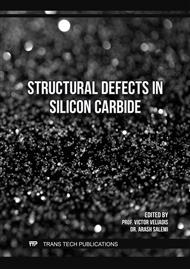p.1
p.7
p.13
p.21
p.29
p.35
p.43
p.49
p.55
Analysis of Lattice Damage in 4H-SiC Epiwafers Implanted with High Energy Al Ions with Silicon Energy-Filter for Ion Implantation
Abstract:
Multi-step high energy ion implantation enables uniform doping to depths up to 12 µm in 4H-SiC epiwafers for superjunction devices but extent of lattice damage is of significant concern for device fabrication. 4H-SiC wafers with 12 µm thick epilayers implanted with Al ions at a concentration of 5 x 1016 cm-3 using the Tandem Van de Graaff accelerator at Brookhaven National Laboratory across an energy range of 13.8 to 65.7 MeV and at different temperatures: room temperature, 300 °C, and 600 °C were analyzed by reciprocal space mapping measurements. Implanted layers exhibited tensile strains that decreased with increasing implantation temperature indicating dynamic annealing effect reduces lattice damage. On annealing at 1700 °C, for recovery of the lattice strain, RSM measurements show that the highest implantation temperatures have the lowest residual strains. In addition, the use of a Silicon Energy-Filter for Ion Implantation (EFII) for Al implantation in a single stage to the depth of 15µm is found to further reduce lattice strain compared to wafers implanted without EFII to the same doping concentration. This preliminary study will assist in optimizing the implantation and annealing conditions for the development of superjunction devices.
Info:
Periodical:
Pages:
29-34
Citation:
Online since:
September 2025
Keywords:
Permissions:
Share:
Citation:


